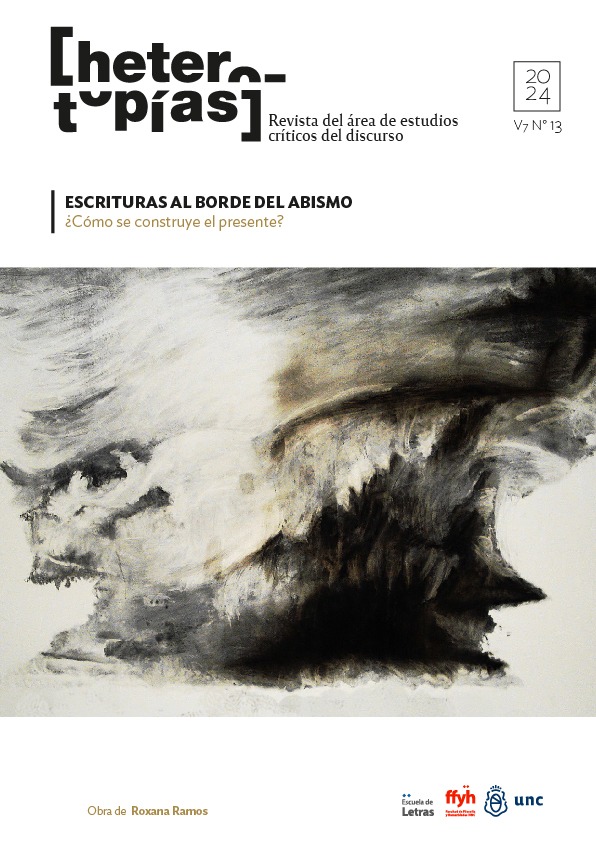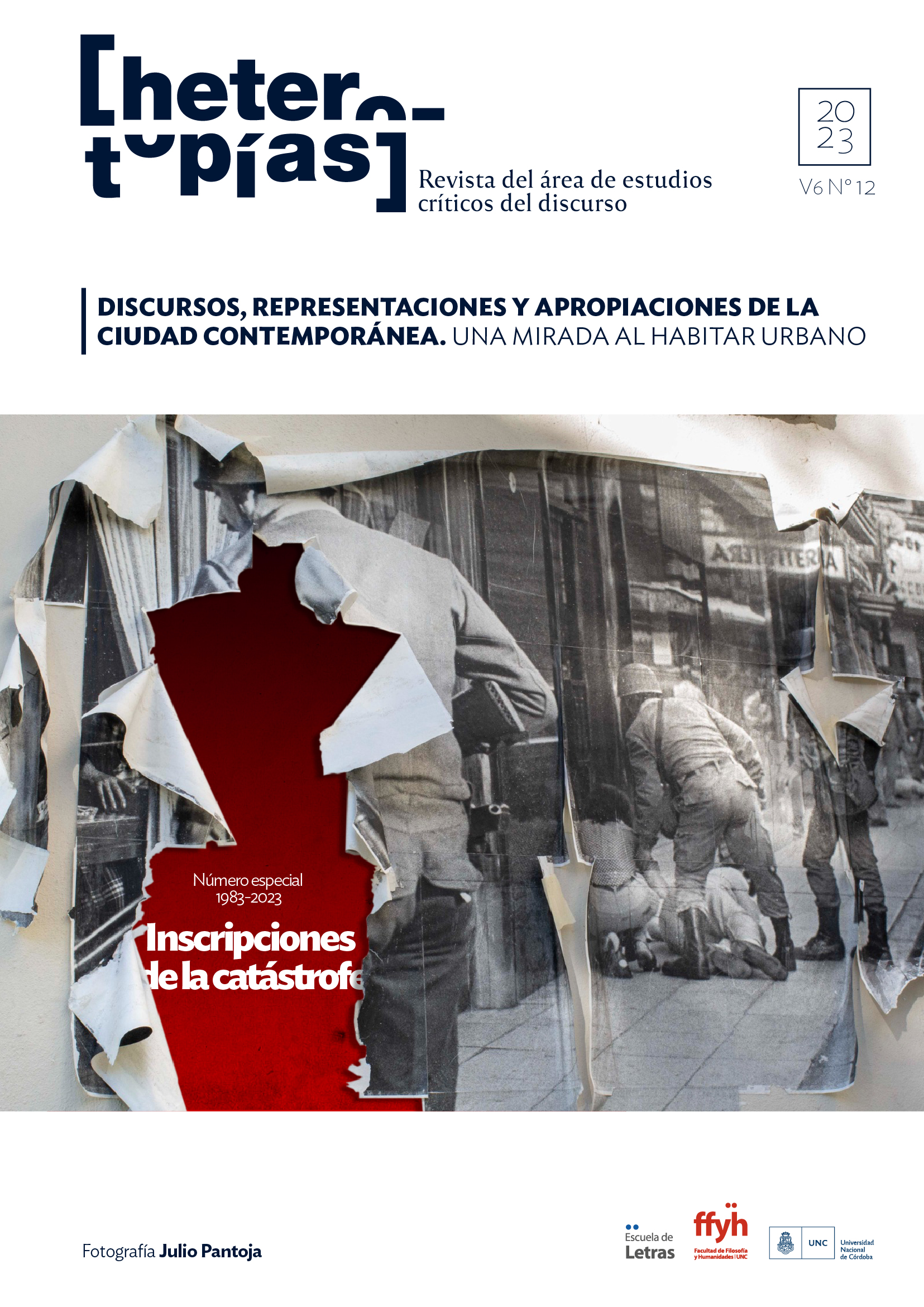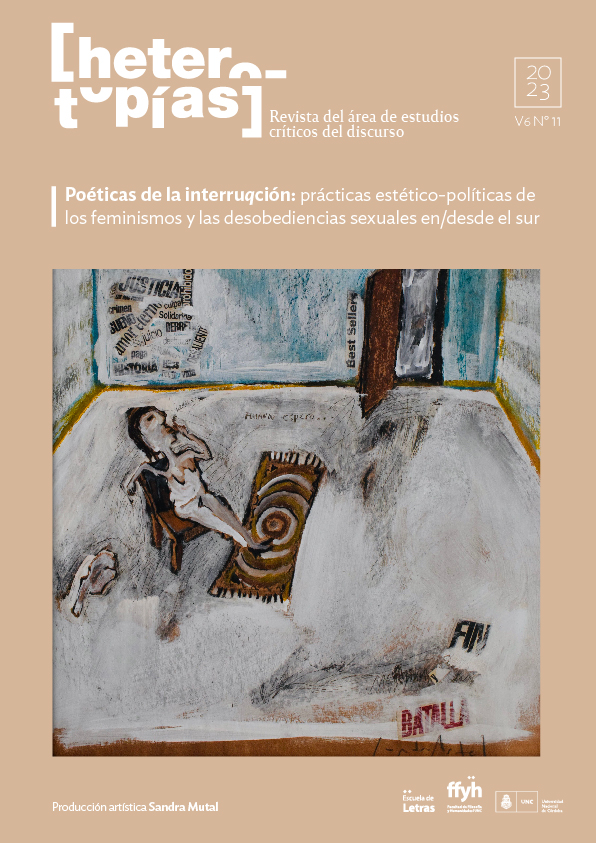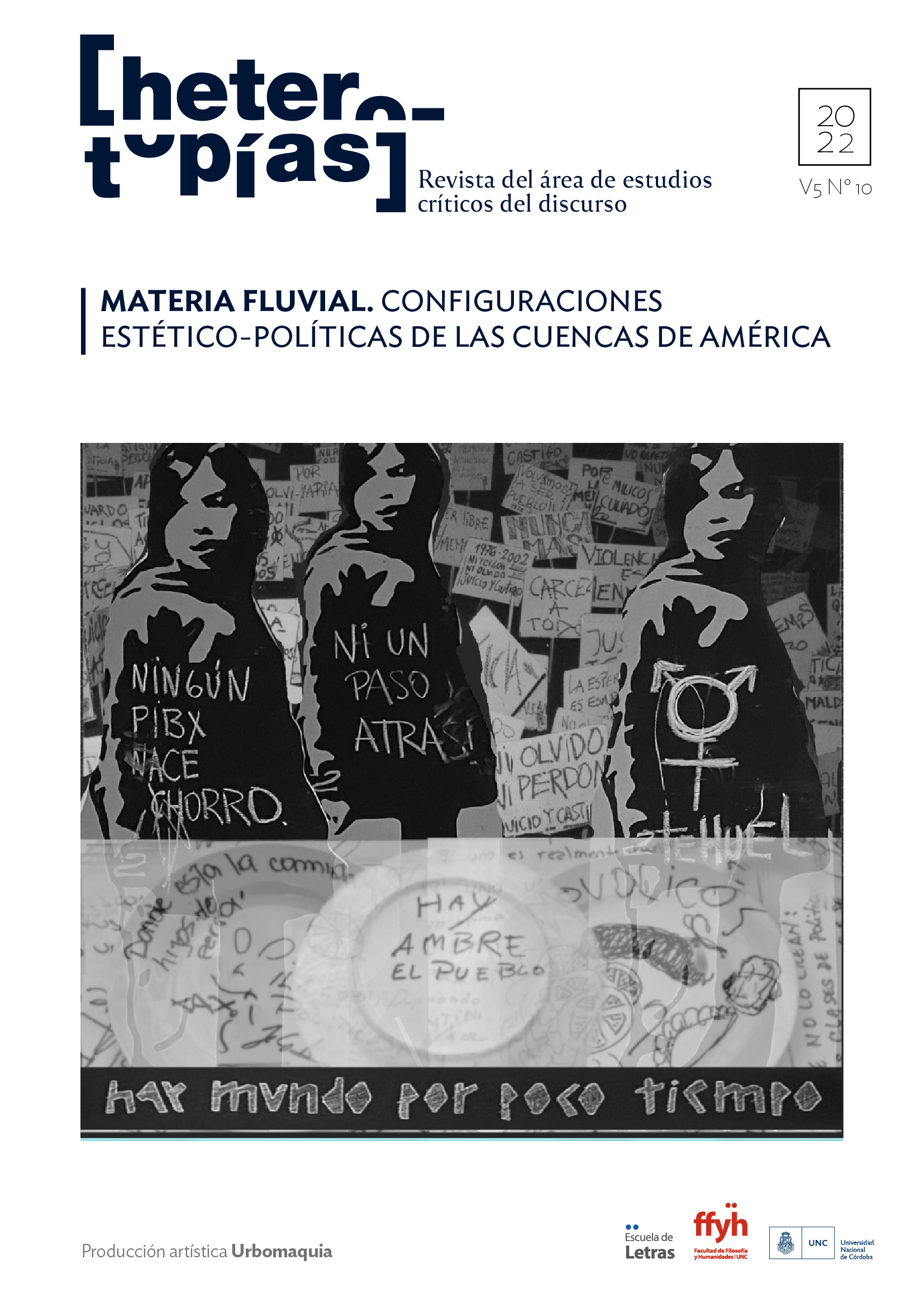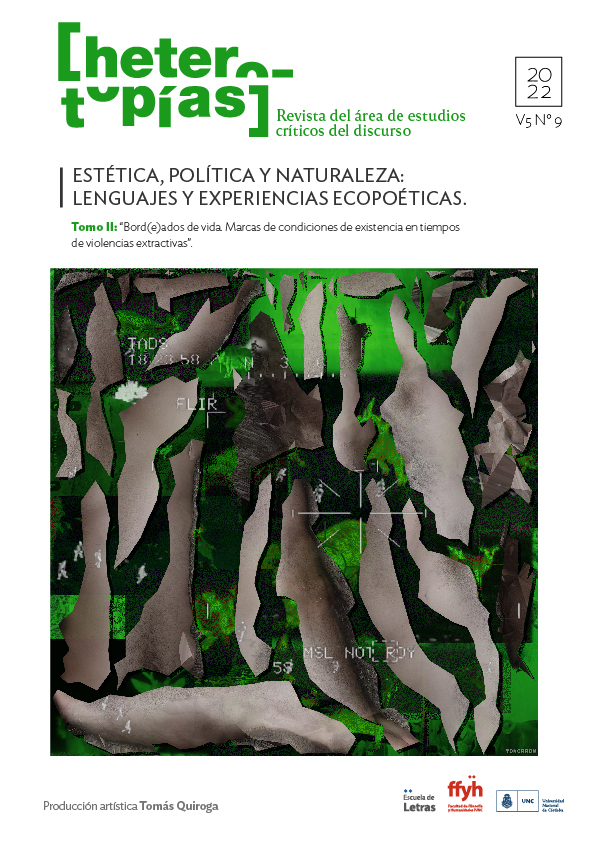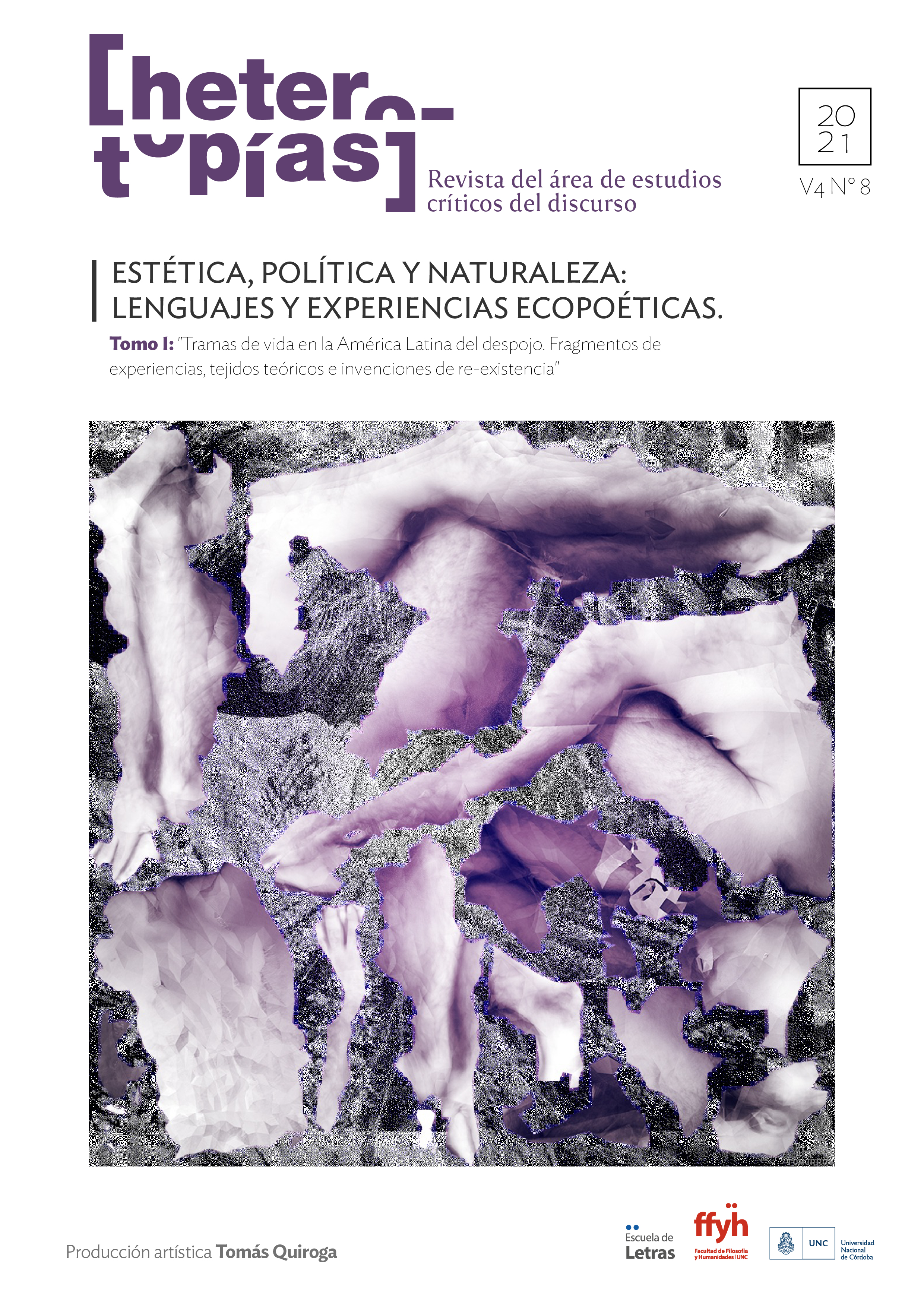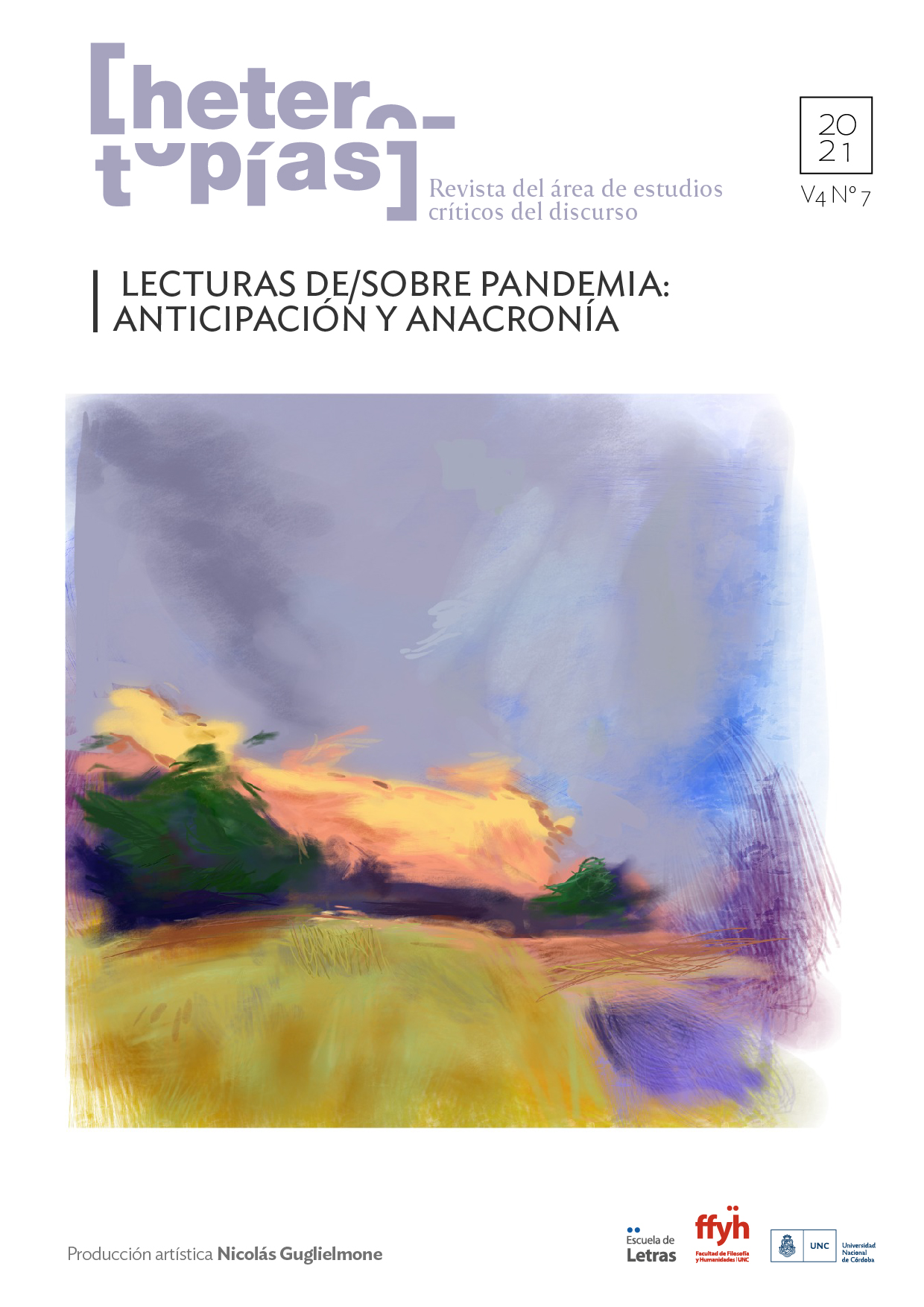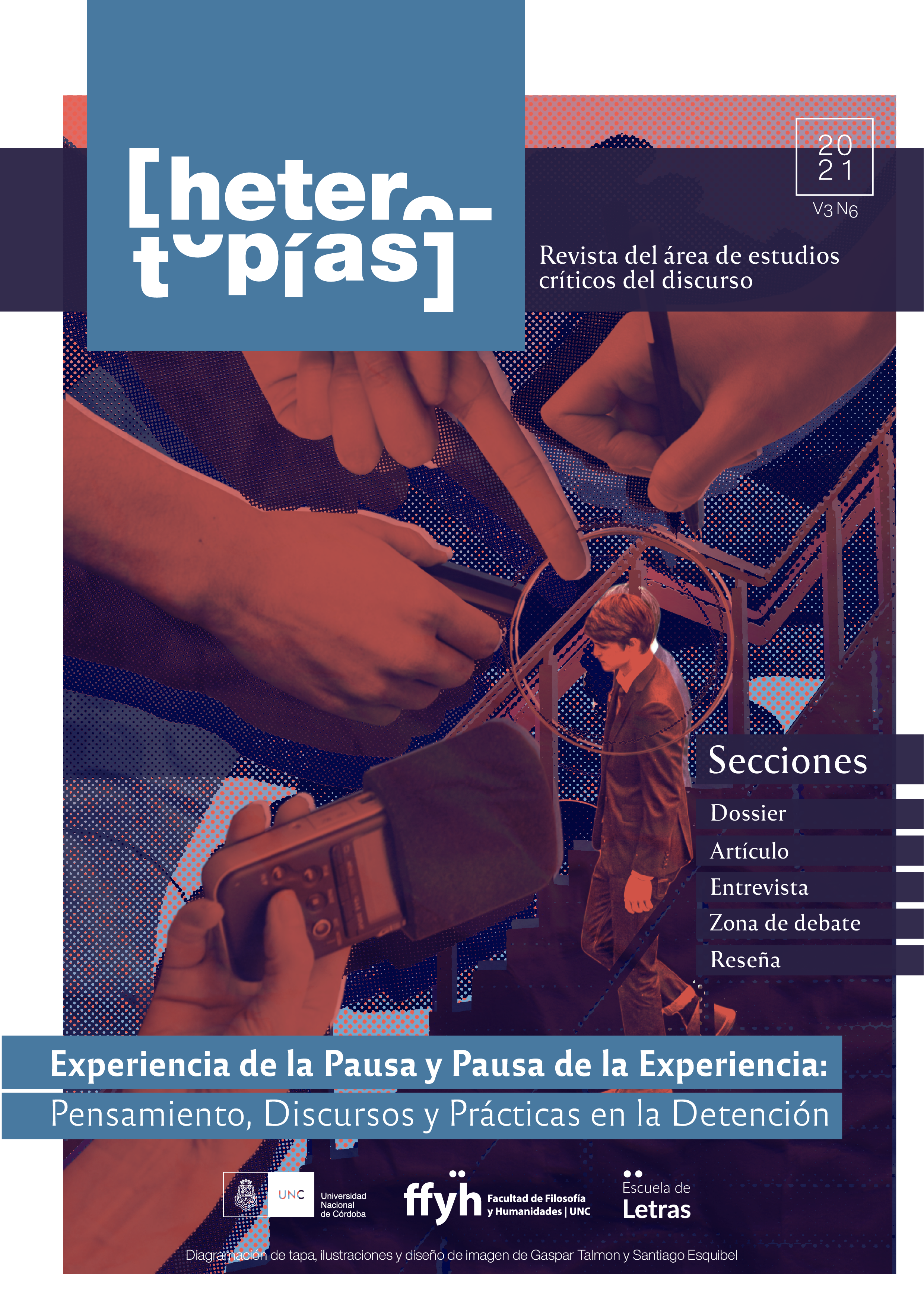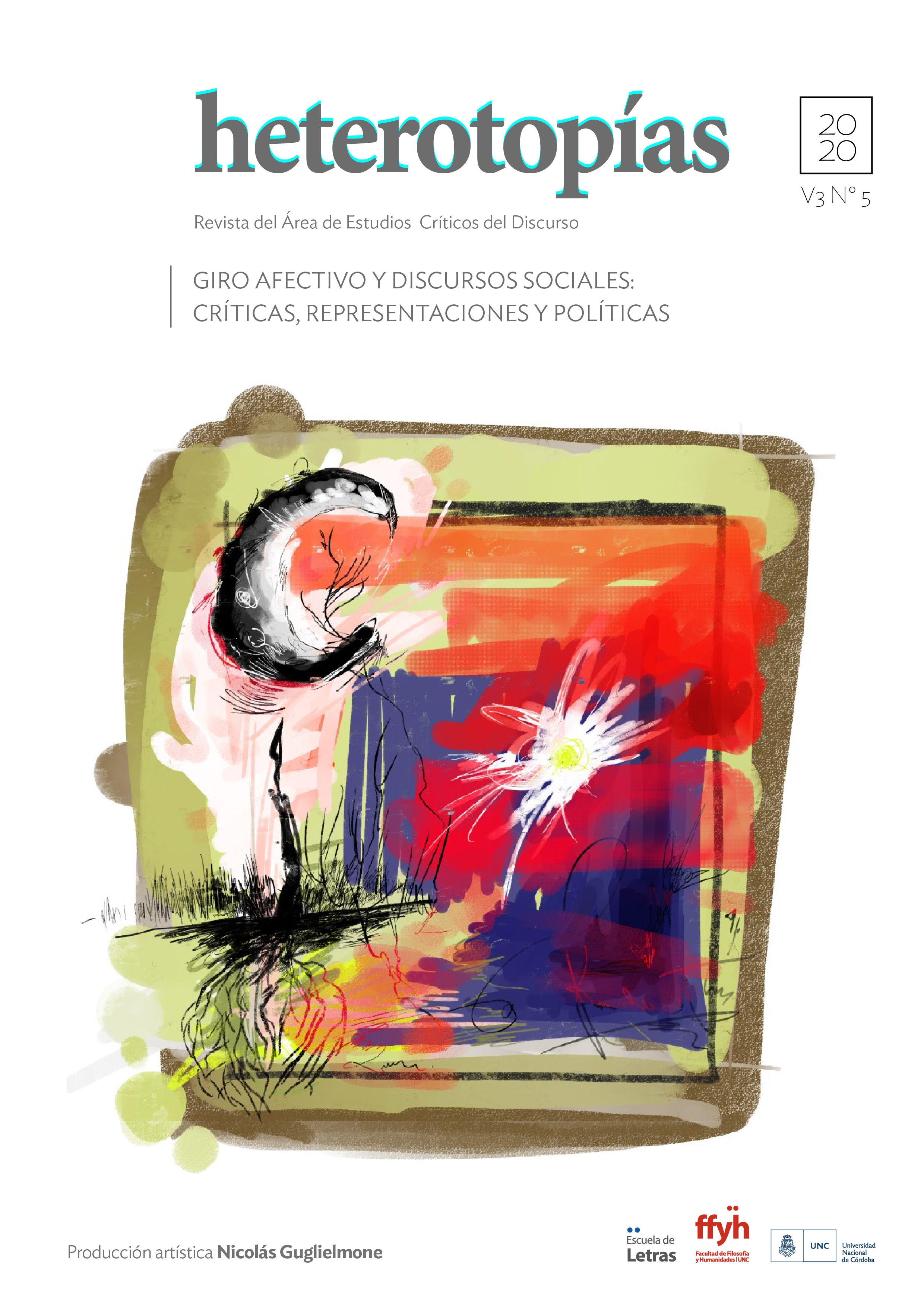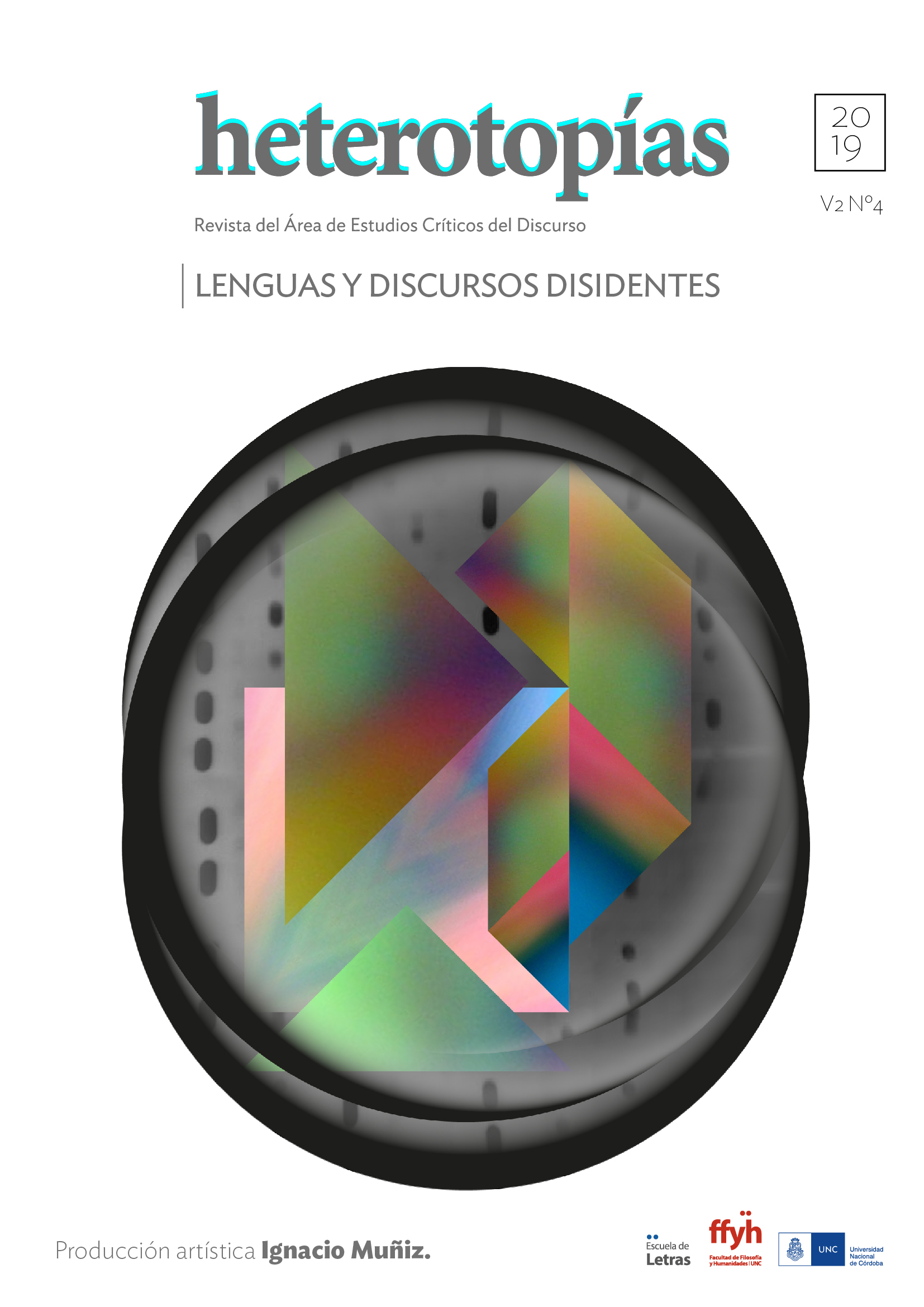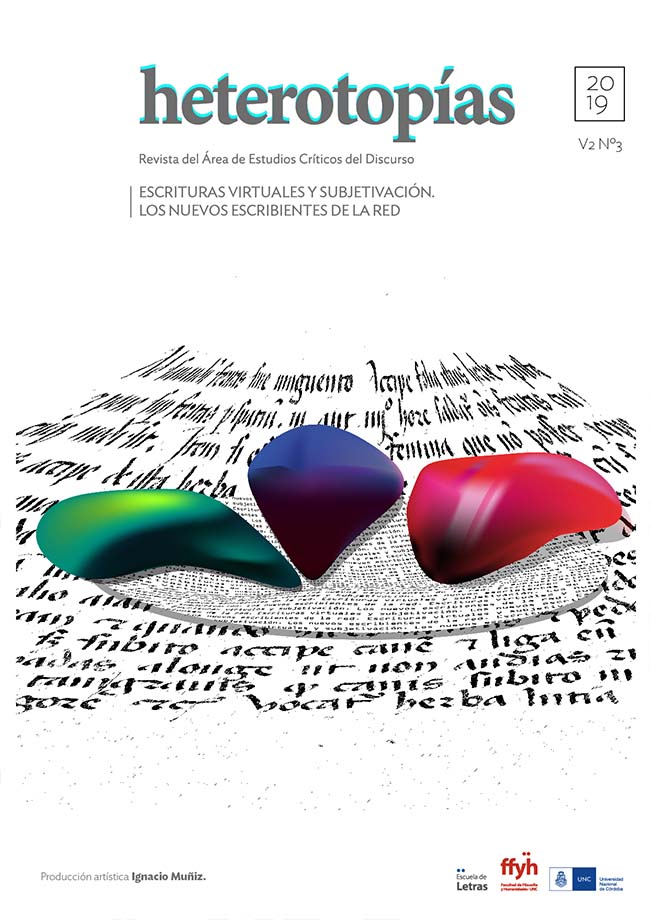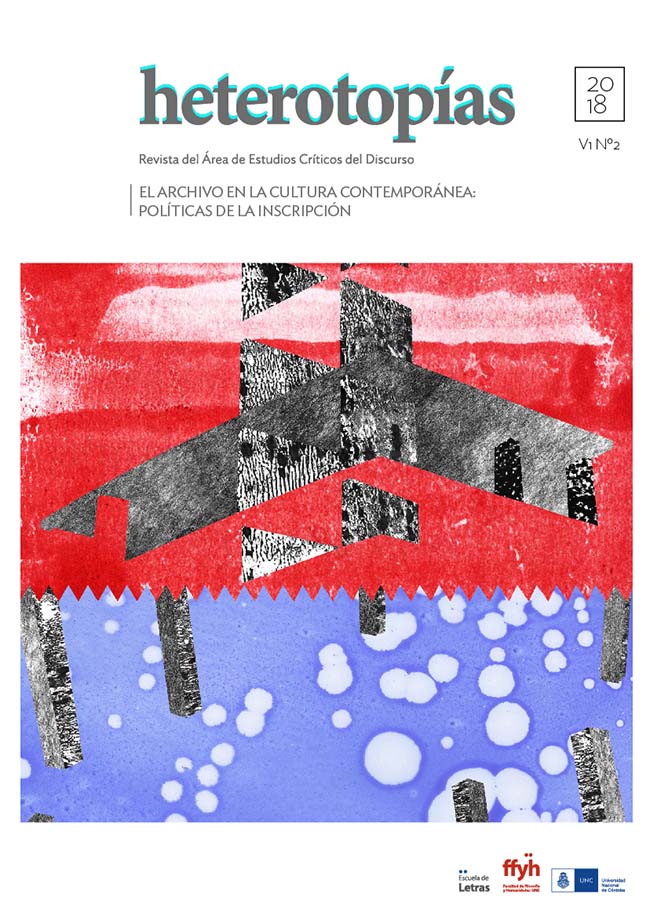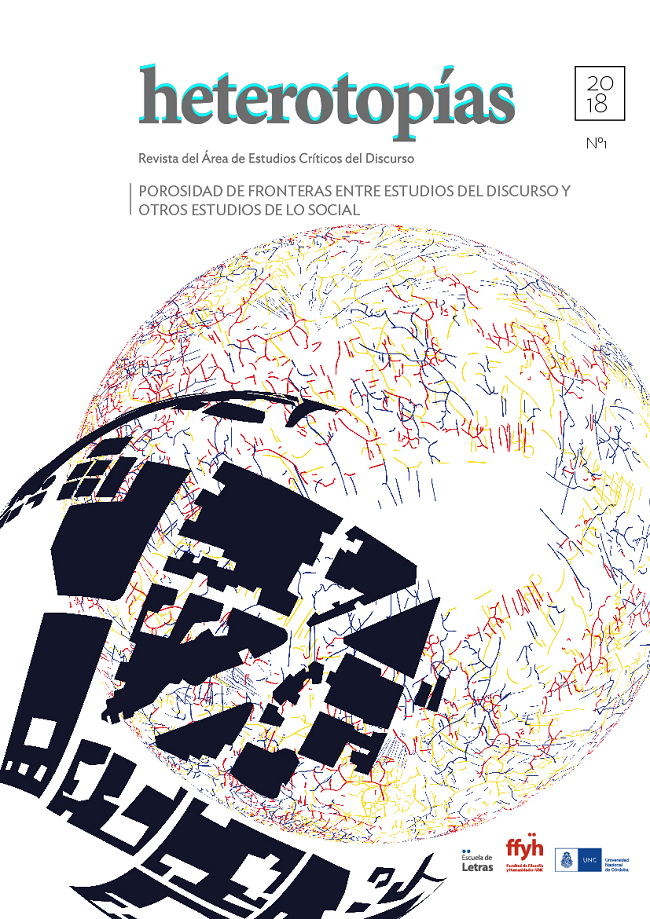Writings on the edge of the abyss: How is the present constructed?
Vol. 7 No. 13 (2024)
The 13th issue of the journal Hetereotopías presents, in addition to its usual sections, a dossier coordinated by Dr. Lucía De Leone and Dr. Nora Domínguez of the Instituto de Investigaciones de Estudios de Género, Facultad de Filosofía y Letras, Universidad de Buenos Aires. The dossier, entitled "Writings on the edge of the abyss: how is the present constructed?", gathers articles that propose a reflection on the personal and collective experiences of traumas, radical anguish, maximum precariousness, imminent catastrophes and extinction that have nurtured with different motifs and forms the obverse and reverse sides of history, accounting for the infinite number of subjective, affective and political variations that constitute the experience of bodies. In the words of the coordinators, our era is marked by the proliferation and lack of hierarchy of writings, by the profusion of styles and proposals, by the multiplication of fictions, and by the questioning of the status and borders of the humanities. In response to this, the dossier proposes a set of personal and collective experiences, always situated and their textual materialities, as part of the gestures of intervention at this juncture.
The cover image of this issue is the work of Salta artist Roxana Ramos. Ramos has a degree in Fine Arts from the National University of Tucumán and a PhD in Humanities with a focus on Arts from the same university. She works as a visual artist, teacher and art manager, with a research focus on art from Salta and contemporary Latin American art. She has received numerous awards and recognitions, among them the "Premio 8 M", from the National Ministry of Culture, the National Fund for the Arts Scholarship for Creation and the Montessori Scholarship from the University of Salamanca, Spain. The e-editorial Bosquemadura of Córdoba will publish in the coming months her ebook Oír lo que queda, tocar la huella. Drawings, sculptural objects, videos, installations and performances, with essays by a team of internationally renowned researchers.
https://www.instagram.com/roxramosnavarro/
Discourses, representations, and appropriations of the contemporary city. A look at urban habitation
Vol. 6 No. 12 (2023)
The issue V6 N12 of Heterotopías entitled "Discourses, representations, and appropriations of the contemporary city. A look at urban habitation" is a special issue because, on the one hand, it includes "Discourses, representations and appropriations of the contemporary city...", coordinated by the architects María Cecilia Marengo and Miriam Liborio, of the Institute of Research on Habitat and Housing (INVIHAB), of the National University of Córdoba, which proposes to integrate urban spaces with social, political, economic, cultural, artistic, and religious processes in dynamics of change. These transformations, both urban, territorial and environmental, merit diverse perspectives, both from the academic sphere and from the praxis of different professions. It is about understanding the city in its constitution, in its relationships, in its contradictions, thinking about the contexts, in which things happen and in the scales that interrelate the different processes that take place in a territory, in addition to recovering the invisible links that exist between them (Silveira, 2019 p.21).
To this important corpus we add another one, which we call "Inscriptions of the catastrophe", since these are sociodiscursive articles that speak of Argentine democracy forty years after its recovery, as "non-closable and non-exhaustive landmarks", a line of work that crosses different sections of this edition.
Both archives propose to make situations visible, to recover from dialogues and facts, emerging and inquiring looks, broad and encompassing complexity, theoretical-conceptual intertwining with practices, value enhancement, discussions on experiences and actions. These approaches are enriched with interviews, reviews and free articles that propose other trajectories adding voices to what has already been exposed.
Cover image by Julio Pantoja. Buenos Aires. 2017. "Remains of a poster on a wall of the ex Esma". In the torn poster you can see a photo of Pablo Lasansky taken on March 30, 1982 of the repression of the CGT workers' march.
"Poetics of interruption: feminist aesthetic-political practices and sexual disobedience in/from the South".
Vol. 6 No. 11 (2023)
In this issue we invite you to reflect around pluri-semiotic practices -visual, sonorous, corporal, oral, scriptural, synaesthetic and multidisciplinary- and contemporary poetics carried out from this southern territory -understood as a locus of critical anticolonial enunciation and not as an identitarian border regime- and from critical feminist perspectives and postcolonial sexual disobediences in order to imagine other possible horizons under thematic axes, such as: dislocated temporality, the archives as affective, epistemological and artistic strategies, political revolts, activisms, advanced bodies and desire, artistic interventions.
River matter. Aesthetic-political configurations of American watersheds.
Vol. 5 No. 10 (2022)
Fluvial scenarios and their surrounding territories have progressively gained notoriety in contemporary debates in Latin America. The great basins of the Amazon, Orinoco and Plata rivers, along with marshes, swamps and aquifers, i.e. the planet's largest drinking water reserve, have gained visibility as a result of the growing concern over the accelerated deterioration of the environment. However, the interest in this issue is not only due to the current political, social and environmental context full of uncertainties, but also to the fact that rivers constituted a fundamental topography both for colonial projects and for the national political-economic imaginaries of the 19th century about which we still, one way or another, debate.
"Aesthetics, politics and nature: languages and ecopoetic experiences" Volume II "Bord(e)ados de vida. Marks of condition of existence in times of extractive violence"
Vol. 5 No. 9 (2022)
This volume, "Aesthetics, politics and nature: languages and ecopoetic experiences", Volume II "Bord(e)ados de vida. Marks of the conditions of existence in times of extractive violence", is a continuation of the previous issue and attempts to accommodate voices and views, the problematization of the relations between the civilizing model, logics of accumulation of transnational capital based on extractivism and the emergence of resistance movements and dissident processes in the face of the advance and expansion of its frontiers that it crosses, undoubtedly, our contemporary condition and puts into focus the interrogation about the (im)possible ways of interweaving the parental of human lives with the non-human (Haraway) in conditions of existence where nature is both limit and horizon. The dossiers of both volumes are coordinated by Mirta Antonelli, Laura Fobbio and Lucrecia Wagner. The purpose of the same is to make visible the aesthetic dimension of creative searches (which include while exceeding the field of art as an institution), and of politically revulsive and dissident activisms with respect to the frameworks (Butler) of monolingualism that regulate and hegemonically control the relations of force in the meanings and senses of nature, common goods, territories, cultures. Going through its pages implies receiving forms of violence, identifying collectives of resistance, situated aesthetic-political experiences and, also, bodily eco-existences, implies facing appropriations and interventions of ecopoetic and ecocritical voices that arise.
“Estética, política y naturaleza: lenguajes y experiencias ecopoéticas".
Vol. 4 No. 8 (2021)
The problematization of the relations between the civilizing model, the logics of accumulation of transnational capital based on extractivism and the emergence of resistance movements and dissident processes in the face of the advance and expansion of its frontiers undoubtedly crosses our contemporary condition and brings into focus the questioning of the (im)possible ways of interweaving the parental of human lives with the non-human (Haraway) in conditions of existence where nature is both limit and horizon.
Although the multidimensionality of the impacts on subjectivities, bodies, territories and ways of life, as well as the kidnapping of languages, cultures and vital semantics are deployed at a global level, it is no less evident that the vectors of violence are intensified regionally, understanding that the concentration in areas of exploitation - mining, gas, oil, soybean, etc. - as well as the phenomena of transference and the phenomena of the transfer of knowledge and knowledge to other areas of the world. as well as the phenomena of transfer, hoarding, privatization by financialization of land, etc., show a concentration in areas and regions, typical of de facto groups (Sklair), which form macro and micro biopolitical devices that transcend national states, geo-referenced democracies, actually existing, and even the limits of citizenship, in processes of regressivity of rights, multifactorial and multiscalar.
This scenario, which requires semiotic, juridical and economic regimes, also boasts, as its reverse and potencies, a vigorous panoply of experiences of cut, disruption, dissidence (Guattari), with respect to the dominant symbolic-imaginary ones, to the devices of monolingualism and the control of possible worlds, in fields of experiences that explore, invent, test vectors of subjectivation/intersubjectivity of sensibilities and other affections, from communal and societal experiences -other politics of (in)equality-, and also from art and the critical thought of human and social sciences, inscribing -in what is pretended to be desert, emptiness, wasteland, and configurations of "efficient territories"-, other languages of valuation (Martínez Alier, Leff) and plurisemiotic enunciations that intervene the distributions of the sensible (Rancière) from dissidences and the search for the opening of possible worlds.
Translated with www.DeepL.com/Translator (free version)
"Readings from/about pandemics. Anticipation and anachrony".
Vol. 4 No. 7 (2021)
Withdrawn from time or eternally present, the contemporary does not establish a comfortable relationship with the now but rather signals a mismatch, a derailment or a maddened time that has something of the phantasmatic about it. Without sinking into the melancholy of a past in which everything was better or into the perishable lightness of the present, the work, the question, the contemporary subject inhabits the present with distance, with a certain anachronism. There would be in the contemporary, then, an immense critical power: due to this particular mismatch with the now, the contemporary would be destined to perceive the dark side of the present and, at the same time, to perceive there the luminosity of our time. And it is precisely on this point that this way of thinking about the contemporary may also be the most accurate way of defining the field of the aesthetic: its ability to capture the wounds, the traumatic dimension, the injustices of our time and, at the same time, its capacity to see there some light that is directed towards us, even if it does not reach us.
With this critical dimension and this utopian moment in mind, we want to think about a corpus of objects - some novels, images and films, but also publishing and cultural projects- that, produced before the pandemic, speak to us about it. It would be a matter of reading, in an effortfully anachronistic way, the way in which the potency of certain works or objects can be revisited in order to speak, in anticipation and blindly, of this pandemic present. It is under these coordinates that we want to think tentatively about the specificity of this pandemic.
"Experience of the pause and pause of experience: thought, speeches and practices in detention"
Vol. 3 No. 6 (2020)
This volume is an invitation "To think belongs both the movement - notes Walter Benjamin - and the stopping of thoughts. There where thinking, in a constellation saturated with tensions, comes to a halt, the dialectic image appears. It is the caesura in the movement of thinking". In another of those texts that, like Benjamin's, have known how to pause and scandalize the movement of our readings, Maurice Blanchot refers to "the legitimate pause, the one that allows the alternation of the conversations, the benevolent, intelligent pause, or also beautiful wait by which two interlocutors, from one bank to another, measure their right to communicate".
The experiences of thought are countless, while the thoughts of experience, those that populate our conversations and our libraries, our meetings and controversies, seem to be characteristically attracted by the figure of something that caesura or interrupts the current and the continuous, pauses and puts in wait. Interrogating this "something" -what is it that in fact stops in the interruption- is a way of inhabiting the interval between the pause, that interval that is also the time of rest and at the same time of resistance, where the heterotopias that we stubbornly think, write and tell ourselves are settled.
"Affective Turn and Social Discourses: Criticisms, Representations and Policies"
Vol. 3 No. 5 (2020)
The focus defined for dossier No. 5 is "Affective turn and social discourses: critiques, representations and policies", whose Coordinators are Eduardo Mattio (FFyH, UNC) - María Victoria Dahbar (CONICET - FFyH and FCC, UNC). It deals with the emotional grammars that regulate our affective-moral responsivity and have already been dealt with by the so-called "affective turn". Under this name, a heterogeneous series of investigations and explorations of supposedly unappealable places of sensibility are brought together. Taking this into account and a series of discussions, this issue aims to bring together contributions that (a) problematize and specify the theoretical dimensions of the affective turn, (b) critically address social discourses and cultural artifacts in which certain affective scripts are acted upon, (c) show the intersections between ethical and political issues raised by emotional grammars, as well as those that (d) examine the uniqueness of discussions on feelings and emotions in the framework of feminisms as a dimension of critique.
“Languages and dissenting speeches”
Vol. 2 No. 4 (2019)
This number includes crossings between reflections and problems, "marginal or marginalized discourses", "ruptures", "discontinuities", "tensions" regarding hegemonic positions and enables "alternative visions", "struggles", "memories", etc, and also It raises the problematization of languages, varieties and marginalized areas of discursivity.
"Escrituras virtuales y subjetivación. Los nuevos escribientes de la Red"
Vol. 2 No. 3 (2019)
La revista Heterotopías en su edición número 3 está dedicada a Héctor (Toto) Schmucler, en memoria a su destacadísima trayectoria en el Área de Estudios Críticos del Discurso y en homenaje al vasto legado intelectual que nos dejara.
El presente dossier tiene como temática "Escrituras virtuales y subjetivación. Los nuevos escribientes de la Red” y está coordinado por las Dras. Silvia Tabachnik y Eva da Porta, editoras invitadas, quienes con su entramado consolidan la multidisciplinariedad que propone esta publicación.
Este número cuenta con producciones colaborativas de investigadores nacionales y del extranjero, el diseño de tapa de Ignacio Muñiz y la revisión de la correctora literaria Luciana Frontoni.
Escrituras críticas, compromisos multiculturales, diversidad lingüística, lecturas en muchas direcciones, mutaciones del lenguaje y miradas disruptivas que ofrecen otras posibilidades de ser, son las ideas que se tejen y entretejen en las páginas de las diferentes secciones que ofrece este número, las cuales invitamos a recorrer y compartir.
El archivo en la cultura contemporánea: políticas de la inscripción
Vol. 1 No. 2 (2018)
Porosidad de fronteras entre estudios del discurso y otros estudios de lo social
Vol. 1 No. 1 (2018)
Este primer dossier explicita, en su enunciación misma, un doble gesto. Por un lado, el de la inscripción de la revista en el revigorizado horizonte, al menos desde los ochenta, de los paradigmas epistemológicos, geopolíticos, económicos y socioculturales de la espacialidad y la territorialidad, con el llamado “giro espacial”. Por otro lado -doble indicialidad del gesto-, este dossier ha buscado performativamente dislocar las fronteras epistemológicas y disciplinarias que delimitan espacios habilitados y saberes legitimados por políticas discursivas, como bien lo indicara Foucault, entre otros, en La arqueología del saber y en El orden del discurso, por sólo mencionar dos de sus textos, siempre revisitados.
El mismo está a cargo de las Doctoras Mirta Antonelli y Gabriela Simón. Cuenta con el aporte, sea en el espacio comité académico o en el de producciones colaborativas con distinguidos investigadores nacionales y del extranjero, con el diseño de tapa de Ignacio Muñiz y la revisión de la correctora literaria María Celeste Aichino.
